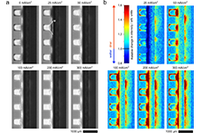Making CO2 usable - high-resolution neutron images show potential for improvement in CO2 electrolysis
CO2-electrolysis promises to convert harmful CO2 into usable chemicals such as carbon monoxide (CO) or ethylene glycol with the help of renewable energy. These, in turn, can serve as feedstock chemicals for alcohols, synthetic fuels or plastics and are thus key to "de-fossilising" the chemical industry.
In CO2-electrolysis, analogous to water electrolysis, i.e. hydrogen production, electrochemical reactions are carried out at two electrodes separated by a membrane. This continuously converts CO2 into CO. The development can therefore be based on previous experience with water electrolysis and with the fuel cell - i.e. the conversion of hydrogen back into electricity, e.g. to power a truck. This is because the cathode electrode is designed as a so-called gas diffusion electrode, similar to the fuel cell. Unlike in the fuel cell, however, in CO2 electrolysis gas diffusion can be impeded by the formation of salts. These salts are formed as an unwanted by-product and prevent the CO2 from reaching the catalyst and being converted into CO. This salt formation was already known, but it has not yet been detected in operation in the cell.
In a cooperation with the Research Neutron Source Heinz Maier-Leibnitz of Technical University of Munich (TUM) and the CNRS Grenoble, the research group "Electrochemical Energy Systems" at the University of Freiburg has now been able to show for the first time in high resolution how salt formation takes place in the electrode. This means that further steps can now be taken to prevent salt formation and thus achieve consistently high efficiency.
The study, published in the journal Nature Communications, can be seen as a prime example of European interdisciplinary cooperation: while the electrochemical experiments were developed at the University of Freiburg, scientists from TUM contributed a neutron detector with record resolution. Finally, all the building blocks were put together in Grenoble, because that is where the CO2-electrolysis experiments were set up at the CNRS neutron reactor and measured with the Munich detector.
Source: https://www.nature.com/articles/s41467-022-33694-y
Contact
Dr. Severin Vierrath
Head of the Junior Research Group „Electrochemical Energy Systems”
IMTEK – Department of Microsystems Engineering
University of Freiburg
Georges-Koehler-Allee 103
79110 Freiburg, Germany
FIT – Freiburg Center for Interactive Materials and Bioinspired Technologies
University of Freiburg
Georges-Koehler-Allee 105
79110 Freiburg, Germany
Phone: +49 761 203 54060
e-mail: severin.vierrath[a]imtek.uni-freiburg.de
URL: www.ees-lab.org

